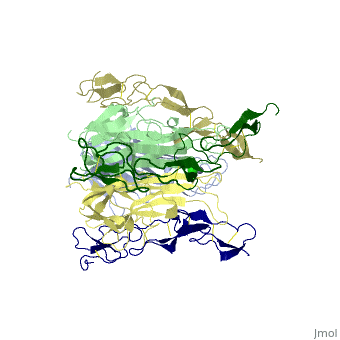1d0g
From Proteopedia
(Difference between revisions)
| Line 3: | Line 3: | ||
<StructureSection load='1d0g' size='340' side='right'caption='[[1d0g]], [[Resolution|resolution]] 2.40Å' scene=''> | <StructureSection load='1d0g' size='340' side='right'caption='[[1d0g]], [[Resolution|resolution]] 2.40Å' scene=''> | ||
== Structural highlights == | == Structural highlights == | ||
| - | <table><tr><td colspan='2'>[[1d0g]] is a 6 chain structure with sequence from [ | + | <table><tr><td colspan='2'>[[1d0g]] is a 6 chain structure with sequence from [https://en.wikipedia.org/wiki/Human Human]. Full crystallographic information is available from [http://oca.weizmann.ac.il/oca-bin/ocashort?id=1D0G OCA]. For a <b>guided tour on the structure components</b> use [https://proteopedia.org/fgij/fg.htm?mol=1D0G FirstGlance]. <br> |
| - | </td></tr><tr id='ligand'><td class="sblockLbl"><b>[[Ligand|Ligands:]]</b></td><td class="sblockDat"><scene name='pdbligand=CL:CHLORIDE+ION'>CL</scene>, <scene name='pdbligand=ZN:ZINC+ION'>ZN</scene></td></tr> | + | </td></tr><tr id='ligand'><td class="sblockLbl"><b>[[Ligand|Ligands:]]</b></td><td class="sblockDat" id="ligandDat"><scene name='pdbligand=CL:CHLORIDE+ION'>CL</scene>, <scene name='pdbligand=ZN:ZINC+ION'>ZN</scene></td></tr> |
| - | <tr id='resources'><td class="sblockLbl"><b>Resources:</b></td><td class="sblockDat"><span class='plainlinks'>[ | + | <tr id='resources'><td class="sblockLbl"><b>Resources:</b></td><td class="sblockDat"><span class='plainlinks'>[https://proteopedia.org/fgij/fg.htm?mol=1d0g FirstGlance], [http://oca.weizmann.ac.il/oca-bin/ocaids?id=1d0g OCA], [https://pdbe.org/1d0g PDBe], [https://www.rcsb.org/pdb/explore.do?structureId=1d0g RCSB], [https://www.ebi.ac.uk/pdbsum/1d0g PDBsum], [https://prosat.h-its.org/prosat/prosatexe?pdbcode=1d0g ProSAT]</span></td></tr> |
</table> | </table> | ||
== Disease == | == Disease == | ||
| - | [[ | + | [[https://www.uniprot.org/uniprot/TR10B_HUMAN TR10B_HUMAN]] Defects in TNFRSF10B may be a cause of head and neck squamous cell carcinomas (HNSCC) [MIM:[https://omim.org/entry/275355 275355]]; also known as squamous cell carcinoma of the head and neck. |
== Function == | == Function == | ||
| - | [[ | + | [[https://www.uniprot.org/uniprot/TR10B_HUMAN TR10B_HUMAN]] Receptor for the cytotoxic ligand TNFSF10/TRAIL. The adapter molecule FADD recruits caspase-8 to the activated receptor. The resulting death-inducing signaling complex (DISC) performs caspase-8 proteolytic activation which initiates the subsequent cascade of caspases (aspartate-specific cysteine proteases) mediating apoptosis. Promotes the activation of NF-kappa-B. Essential for ER stress-induced apoptosis.<ref>PMID:15322075</ref> [[https://www.uniprot.org/uniprot/TNF10_HUMAN TNF10_HUMAN]] Cytokine that binds to TNFRSF10A/TRAILR1, TNFRSF10B/TRAILR2, TNFRSF10C/TRAILR3, TNFRSF10D/TRAILR4 and possibly also to TNFRSF11B/OPG. Induces apoptosis. Its activity may be modulated by binding to the decoy receptors TNFRSF10C/TRAILR3, TNFRSF10D/TRAILR4 and TNFRSF11B/OPG that cannot induce apoptosis. |
== Evolutionary Conservation == | == Evolutionary Conservation == | ||
[[Image:Consurf_key_small.gif|200px|right]] | [[Image:Consurf_key_small.gif|200px|right]] | ||
| Line 33: | Line 33: | ||
==See Also== | ==See Also== | ||
*[[TRAIL|TRAIL]] | *[[TRAIL|TRAIL]] | ||
| - | *[[Tumor necrosis factor receptor|Tumor necrosis factor receptor]] | + | *[[Tumor necrosis factor receptor 3D structures|Tumor necrosis factor receptor 3D structures]] |
== References == | == References == | ||
<references/> | <references/> | ||
Revision as of 06:29, 11 August 2021
CRYSTAL STRUCTURE OF DEATH RECEPTOR 5 (DR5) BOUND TO APO2L/TRAIL
| |||||||||||


